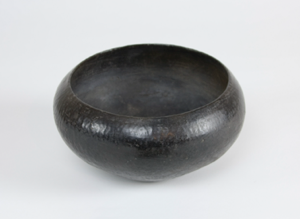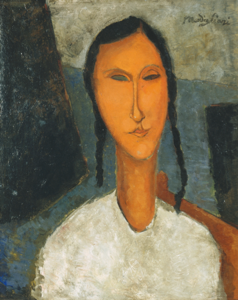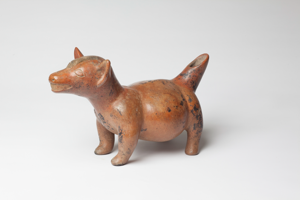FILTER RESULTS
Ramos Blackware Bowl
1200 - 1450 CE13th-15th century
7 1/2 in. (19.05 cm)
Casas Grandes, Mexican
Object Type:
Pre-Columbian
Medium and Support:
Blackware
Credit Line:
Gift of William O. Gross Jr.
Accession Number:
1990.017
Object Description
Gourd-shaped black clay bowl with unusual "hammered" texture (Ramos Blackware). Ramos Black was defined by Archaeologist Edward B. Sayles (1936). This type is characterized by a black surface that reflects smudging during the final stages of firing, often over a slipped red surface (DiPeso and others 1974; Sayles 1936). Surfaces are commonly black and extremely polished on both surfaces. Red paste with a black core is common, although some have a black paste. Patches of red may be observed on the exterior surface. Vessel forms include closed bowls, jars, and effigies.Smudged forms may occasionally exhibit incised decorations similar to those described for Playas Incised Red. Di Peso’s suggested derivation from Convento Red, Chipicuaro Black, or black ware from southern Nayari. This type also resembles types known to have been produced in areas of the Mogollon region to the north including Reserve Smudged from the Mogollon Highlands as well as Tewa or Kapo Black that was much later produced in the Northern Rio Grande region.
Keywords
Click a term to view the records with the same keyword
This object has the following keywords:
Additional Images
Click an image to view a larger version
Exhibition List
This object was included in the following exhibitions:
- Ancient Americas in a New Light , 2/26/2022 - 8/20/2022
Bibliography List
This object has the following bibliographic references:
- Melissa S. Powell, ed. Secrets of Casas Grandes. Museum of New Mexico Press. Santa Fe, NM, 2006
Portfolio List
Click a portfolio name to view all the objects in that portfolio
This object is a member of the following portfolios:



